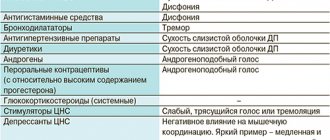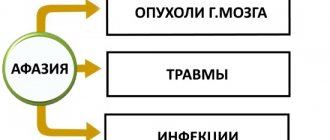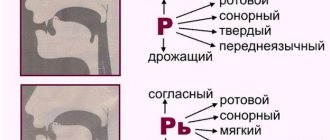- home
- Speech disorders
Loss of voice, in which a person can speak in a whisper, is called aphonia: this condition is encrypted in MBK-10 with the code R49.1. This condition is sometimes confused with dysphonia. In contrast, aphonia is something that causes a complete loss of voice: there is no hoarseness, hoarseness - only a whisper is available for speaking. There is one common factor between these two diseases - impaired speaking function, but the mechanism of its occurrence is different.
Symptoms
In addition to the inability to speak loudly, the following symptoms occur:
- pain in the larynx;
- difficulty swallowing;
- spasms in the vocal cords.
When symptoms of aphonia appear, the doctor’s task is to search for the causes of this pathology, because this disorder is a consequence of another disease - neurological, mental, functional or organic.
The process of voice formation.
Voice formation is a very complex process controlled by two parts: central and peripheral. The central section is the brain and nerves. Peripheral - these are the “executors” of brain commands (lungs, trachea, larynx, lips, tongue, jaw, palate). Each of the above organs plays an important role in voice formation.
The origin of sounds occurs in the larynx at the moment when the flow of air leaving the lungs passes through the vocal cords located directly on the larynx. The vocal cords are folds of the mucous membrane of the larynx. During breathing, when a person is silent, the ligaments are relaxed, and there is a distance between them called the glottis. To form a voice, it is necessary that when air passes through the vocal cords, they are tightly closed. In this case, the air flow causes oscillations and vibration of the ligaments - this is how a sound wave arises.
We can draw a logical conclusion: if there is a loss of voice, then the reason lies in non-closure or incomplete closure of the vocal cords.
Forms of aphonia
There are 4 different forms of aphonia, which are divided according to 2 characteristics - origin and mechanism of damage.
- True aphonia appears when the larynx is affected as a result of various forms of infectious diseases that are localized in the larynx area. For example, with acute laryngitis, diphtheria croup. The cause may also be paralysis of the laryngeal muscles resulting from head injuries or stroke. Another reason is a neoplasm that prevents the closure and vibration of the ligaments.
- Paralytic aphonia, which becomes the result of surgical interventions on the throat or a consequence of intoxication that appears against the background of an infectious disease. Sometimes the paralytic form occurs due to the development of diseases of the nervous system, for example, syringomyelia. This condition occurs due to the fact that the lower laryngeal nerve is affected.
- The spastic form, unlike the paralytic form, manifests itself in the form of a spasm of the muscles of the larynx. Due to this contraction, the gap between the vocal cords becomes narrow and vibration is impossible. This form is characterized by pain in the larynx and difficulty swallowing, because spasmed muscles do not allow a bolus of food to pass through.
- Aphonia, as a functional disorder, is the result of a violation of reflex mechanisms, as well as overstrain of the vocal cords by singing and shouting. This form of aphonia is also called psychogenic, since its cause is intrapersonal or social conflict. Most often, this form occurs in women as a result of stress and hysteria. This is approximately how hysterical mutism occurs, in which the voice disappears, but the ability to laugh and cough remains. The mechanism of occurrence in this case is the irradiation of a strong nerve impulse so much that the department responsible for controlling phonation falls into this zone.
One form of this disease can evolve into another over time.
For example, a patient underwent surgery on the thyroid gland, which led to loss of voice. Over time, the function was restored, and after a while, against the background of severe emotional shock, it disappeared again. That is why, before prescribing a treatment regimen, you need to collect an anamnesis that will help you understand the causes of voice loss.
Voice disorders. Dysphonia, Aphonia, Phonosthenia.
After working with a psychiatrist, preparation for breathing work begins. If the laryngeal nerve is damaged during paralysis, then it will be almost impossible to restore its motor function. In other cases, functional training is required. The exercises will increase the mobility of the healthy part of the larynx, and in case of paralysis, they will partially restore the mobility of the vocal fold.
The next step is to normalize physiological breathing and phonation. Classes should be aimed at normalizing breathing and begin with “blowing into a harmonica.” You need to blow slowly, inhaling and exhaling on the same note. Healthy children should start training with 1 minute 10 times a day, gradually increasing the time to 2 minutes and 15 repetitions per day. If you feel dizzy, you should reduce the exercise time to 15-20 seconds.
This activity lengthens the exhalation, and the uniform movements of inhaled and exhaled air massage the larynx, thereby increasing the mobility of the healthy part of the larynx and activating the paralyzed part. In combination with “blowing into a harmonica,” breathing exercises are recommended that train extended exhalation:
Complex A. Sit straight in a chair or stand up:
1) Take a quick shallow breath and then a long exhale;
2) Inhale through your nose and exhale through your mouth;
3) Inhale through your mouth, exhale through your nose;
4) Inhale and exhale with only one half of your nose, then the other;
5) Inhale through one half of your nose and exhale through the other;
6) Inhale through your nose and then exhale slowly with increasing force at the end;
7) Inhale through your nose, exhale through loosely pursed lips;
 Inhale through your nose, exhale through your nose while holding your breath.
Inhale through your nose, exhale through your nose while holding your breath.
Do not start doing breathing practices and exercises right away so as not to overload the patient. Do breathing exercises for about a week, and then add exercises for the muscles of the neck and larynx.
Complex B. To perform the exercises described below, you need to sit up straight:
1) Place your hands in a lock at the back of your head, tilt your head back and apply slight resistance with your hands;
2) Clench your hands into a fist and rest your hands on your chin, then tilt your head forward, providing resistance with your hands;
3) Cover your ears with your palms, then tilt your head towards your shoulders with resistance from your hands;
4) Squeeze your jaws, and then move your lower jaw down, to the sides, forward;
5) Puff out your cheeks;
6) Use the tip of your tongue to reach the roof of your mouth;
7) Raise your palate when you yawn.
The above workouts are very easy to do. It is recommended to perform them 6 times during the day, repeating each approximately 5 times.
When combining exercises with a speech therapist and classes to establish diaphragmatic breathing, the reflex cough will disappear, exhalation will significantly lengthen and weak oscillatory movements of the paralyzed part of the larynx will appear. The next step is exercises for voice coordination. The essence of these exercises is that the vibrations of sound affect the mechanism of voice formation. With regular practice, the correct acoustic effect is achieved, which is what voice production consists of.
The correction begins with the pronunciation of the letter {m}, which allows you to establish the correct phonation.
Exercise 1 . Pronounce the sound slowly and briefly, directing it so that it “hits” the roof of your mouth, thereby causing resonance. After a couple of training sessions, the phonations will become longer and the voice will sound clearer. When the exercises no longer cause difficulties, proceed to the pronunciation of open syllables.
Exercise 2 . First, pronounce one sound {m}, then alternate vowels with this sound, for example: ma, mo, mu, me, we. At the same time, sharply lower your lower jaw. To consolidate the result, after a couple of lessons, you need to pronounce the syllables, with the emphasis on the second word.
Exercise 3. Pronounce the following syllables: - ma-ma na-na; - ma-mo na-no; - ma-moo na-well and so on.
Exercise 4 . Say the following syllables: mom-mama-mama; nana-nana-nanana and so on.
When the syllables sound loud and full, you can move on to the next task. Exercise 5. Say the sound {th} in combination with vowels
Repeating vowels on a hard attack has a positive effect on the closure of the vocal folds. Pronounce the vowels briefly and firmly, and the sound {th} for a long time: ay... yai..., oh... her..., uh... yu..., hey... her...
After the above activities, coordination of breathing and voice production is necessary. To achieve this, pronounce vowel sounds in one exhalation. Exercise 6 . Pronounce syllables with vowels, for example: a, ao, ay, ae, ai, aou, aoe, aoi, aouei, aoui, etc.
The child must repeat the syllables, first after the speech therapist, then independently.
Pronouncing the combinations easily and without complaints, you can move on to the next stages of treatment - working on the restored voice. To work it out, the following syllables are rehearsed: ma, mo, mu, me, we. Gradually starting phrasal speech and reading.
When working with speech material, it is recommended to practice vocals. Exercises will help strengthen your voice and increase sonority. You can sing triads, melodies without sharp transitions or scales.
When the voice is restored, it sounds loud, accompanied by organized breathing, and there is no unpleasant sensation in the throat. During the examination, the vocal folds close, and their vibrations are visible on the affected part of the larynx.
The duration of rehabilitation work lasts up to 4 months, the duration of treatment depends on the severity of the disorder and the time of start of classes.
Causes
They began to study seriously what aphonia is and what causes it already in the 50s. Before the Second World War, doctors only settled on the fact that the loss of voice was caused by mental disorders and hysterical conditions.
The development of diagnostic tools and the expansion of the range of surgical interventions have led to an expansion of the range of causes of complete loss of voice:
- Infectious diseases of the larynx, due to which the soft tissues become inflamed and spasm. This category also includes diseases of the lower respiratory tract, which cause the development of an inflammatory process along the path of air passage.
- Overstrain of the vocal cords due to professional activities. In such cases, dysphonia may first develop, which, if left untreated, turns into aphonia. This reason causes the development of true or spastic aphonia.
- Neoplasms in the larynx.
- Traumatic injuries resulting from accidents or after medical procedures. For example, after intubation an organic form is observed.
- The toxic effects of tobacco smoke, an environment with a high concentration of gases, as well as work in hot workshops at industrial enterprises - all this provokes the development of laryngeal pathology.
- Prolonged exposure to cold and dry air, which is typical for mountainous areas.
- Psychogenic nature: fright, an attack of great fear, nervous shock, conflict with a high charge of emotions - all this provokes the release of a large dose of adrenaline and the expansion of the excitation zone in the cerebral cortex. This group of factors causes functional aphonia.
- Disturbance of the innervation of the lower laryngeal nerve, which occurs in 4 cases: diseases of the nervous system, cerebral hemorrhages, trauma and surgery. In such cases they speak of a paralytic form of aphonia.
What is aphonia? Causes and methods of treatment.
Sazhin Alexander Valerievich – PhoniatristHead of the Department of Otorhinolaryngology
Specialty: phoniatrist, otorhinolaryngologist, ENT surgeon, otoneurologist.
Education: 1991 - Graduate of the Pediatric Faculty, Perm State Medical Institute, Perm. 1992 - internship in pediatrics, Perm State Medical Institute, Perm. 1995 – primary specialization in otorhinolaryngology, Novokuznetsk State Institute for Advanced Medical Studies, Novokuznetsk. 2003 – thematic improvement in pediatrics, State Educational Institution of Higher Professional Education Perm State Medical Academy named after. E.A. Wagner (PGMA), Perm. 2003 – thematic improvement in clinical lymphology, State Educational Institution of Higher Professional Education Perm State Medical Academy named after. E.A. Wagner, Perm. 2003, 2008, 2011, 2013 – thematic improvements in otorhinolaryngology, Perm State Medical Academy, Perm. 2013 – practical improvement on the topic “Functional endoscopic rhinosinus surgery”, Kazan State Medical Academy, Kazan. 2012-2014 – residency in the specialty “Otorhinolaryngology”, Perm State Medical Academy. 2015, May - IV Russian master class “Modern functional rhinosurgery”, Moscow, Federal State Budgetary Institution “Polyclinic No. 1”, Department of Administration of the President of the Russian Federation. 2016, November – educational and practical master class “Otoneurology. Modern methods of diagnosing dizziness with a practical course,” Department of Otorhinolaryngology, Russian National Research Medical University named after. N.I. Pirogov (Russian Research Medical Institute named after N.I. Pirogov), Moscow. 2021, October - thematic improvement in phoniatrics at the FMBA of Russia (Federal Medical and Biological Agency of Russia), Moscow. 2021, November – master class “Otoneurology. Modern methods for diagnosing dizziness", Department of Otorhinolaryngology, Russian National Research Medical University named after. N.I. Pirogova, Moscow. 2021, May – VI Russian master class with international participation “Modern functional Rhinosurgery”, Moscow.
Main services:
- reception of adults and children from 0+;
- diagnosis, treatment and prevention of diseases of the vocal apparatus;
- endoscopic methods of diagnosis and treatment of ENT organs;
- surgical treatment of the nose, paranasal sinuses, larynx, pharynx;
- reconstructive surgery of ENT organs;
- radio wave surgery, cryotherapy.
Diagnostics
Comprehensive diagnostics helps to identify the true causes of aphonia. To do this, use the following list of studies:
- Anamnesis collection and its detailed analysis.
- Examination of the larynx with taking a smear from the mucous membrane to determine the causes of the development of the inflammatory process.
- Laryngoscopy for a detailed examination of the mucous membrane
- To exclude the development of tumor processes, the following set of studies is prescribed: ultrasound, x-ray, computed tomogram of the neck and chest area.
- If there are neoplasms, a biopsy is performed.
It may also be necessary to consult a neurologist, endocrinologist, surgeon, psychiatrist, or psychologist.
Treatment
Therapy for aphonia requires an integrated approach. In some cases, this is antibacterial and herbal medicine in combination with physiotherapeutic procedures, in others - a complex of psychotherapy and breathing exercises. In any case, you need to follow a vocal mode to reduce the load on the vocal cords.
More radical measures include excision of scars on the vocal folds and removal of the tumor. For spastic aphonia, massage of the collar area is possible, which helps relax the muscles of the larynx. With their paresis, a direct therapeutic effect on the larynx area, unfortunately, will not bring any effect. It is necessary to eliminate the neurological cause, since in such cases paralytic aphonia is a symptom, part of the manifestation of the picture of another disease.
Prevention
In order to avoid illness, you need to take care of your voice: do not shout, do not talk for a long time in severe frost, adjust the volume of your voice when talking and singing. It is very important to regularly visit an otolaryngologist, promptly treating diseases, and preventing the occurrence of chronic foci of infections. Smokers need to give up the addiction, which has a huge impact on the voice. Don't forget to strengthen your immune system by taking vitamins, vegetables and fruits. Eat a properly balanced diet and remember to get at least a healthy 8 hours of sleep.
Make an appointment with a doctor in Moscow:









